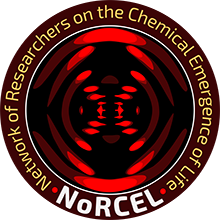Protocells are often conceived as bilayer-ensheathed life precursors, whose self-reproduction necessitates the earlier emergence of replicating biopolymers with catalytic capacities. We have explored the alternative scenario, whereby nanoscopic lipid micelles with catalytic capabilities were forerunners of biopolymer-containing vesicles.
This postulate gains considerable support from extensive experimental literature on micellar catalysis and on autocatalytic proliferation of micelles. Augmented evidence resides in recent reports on mixed micelles, showing non-equilibrium steady-state homeostasis in a self-reproducing molecular ensemble. All of these life-like attributes reinforce the idea that catalytic micelles, just like ribozymes, are capable of both catalysis and self-copying, hence the term “lipozymes”. Such entities could undergo compositional reproduction, driven by endogenous mutually catalytic networks, that propagate compositional information and are capable of primal selection and evolution. One of the recent activities in our laboratory addresses the question of how specific molecular recognition events can emerge on a fluid micellar surface. We discovered widespread reports on what is known as dynamic aptamers, the supramolecular analogs of selection-identified covalent oligomers with recognition functions.
There is substantial published evidence that just as catalytic dyads and triads underlie effective catalysis by protein enzymes with rigid folding, micelles are shown to harbor significant catalysis based on dynamic proximity and disposition of heterogeneous lipid headgroups on a micellar surface. We have also critically assessed the underpinnings of our chemically-rigorous computer-simulated GARD model for collectively autocatalytic sets. We now have a better explanation as to how the model’s emergent chemical dynamics indeed predicts and strengthens the abovementioned origin of life implications of the mixed micelles experiments. One key observation in our recent GARD simulations is that molecular networks within micelles behave as dynamic attractors. This means that the transition from random composition to such capable of self-copying can be much faster than previously expected, suggesting rapid chemical prebiotic evolution.
To help fathom the paths for subsequent protocellular complexification en route to LUCA, we extend the GARD model, relying on experimental studies reporting how catalyzed lipid modifications could underlie both micelle to vesicle transition and monomer to biopolymer progression. Such graded progress takes place within a protocellular entity that continuously preserves the capacity for homeostatic reproduction. In other words, while complexity of individual molecules and of the protocell’s composition gradually increases, this molecular ensemble preserves the essential property of catalysis-driven effective reproduction under selective pressures. Finally, we point out that unlike biopolymer-harboring vesicular protocells, micellar protocells can withstand high levels of exogenous chemical diversity and extreme environmental conditions, enhancing the realism of planet-scale micellar life emergence.
This could help bridge the gap between life’s early initial steps, which may have involved highly resilient lipid assemblies, and the more delicate molecular structure of LUCA. Such argument further substantiates our proposed inference that protocellular evolution could have been seeded by chemically-simple lipid assemblies, which likely predated forms of early life that depended on RNA-based information transfer.


